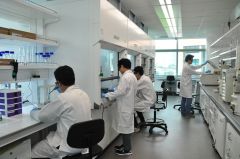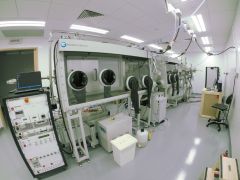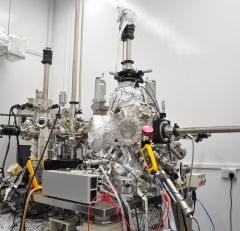Our Facilities
The primary SinBeRISE research facilities are housed at the CREATE campus with additional labs housed at the three participating universities and the Lawrence Berkeley National Laboratory. These facilities allow the researchers the ability to grow and characterize new materials systems for solar energy applications.
Processing Laboratory
(CREATE Research Wing #04-01)
 The chemical labs at SinBeRISE host all key equipment necessary for synthesizing and evaluating a wide variety of functional electronic materials key for the realization of solar cells and photoelectrochemical processes. Besides facilities necessary for synthesis of oxide and chalcogenide nanomaterials, extensive organic synthesis facilities is set to allow the preparation of novel multidimensional halide perovskite precursors, hole transport layers and conjugated polyelectrolytes. Key equipment assembled include:
The chemical labs at SinBeRISE host all key equipment necessary for synthesizing and evaluating a wide variety of functional electronic materials key for the realization of solar cells and photoelectrochemical processes. Besides facilities necessary for synthesis of oxide and chalcogenide nanomaterials, extensive organic synthesis facilities is set to allow the preparation of novel multidimensional halide perovskite precursors, hole transport layers and conjugated polyelectrolytes. Key equipment assembled include:
- Multifunctional glovebox system with integrated thermal evaporator, spincoater and solar simulator: For preparation of novel multifunctional perovskites, formation of functional films through spin coating as well as fabrication and testing of photovoltaic devices in completely inert atmospheres to understand key aspects that affect their optoelectronic behavior.
- Complete photoelectrochemical characterization systems: Clear and accurate analysis of photoreaction products are enabled by custom-made photocatalytic reactor systems which incorporate an in-line gas chromatography system.
- Advanced device characterization: Electrical and optical small amplitude perturbation techniques for the dynamic performance characterization of photovoltaic devices and photoelectrodes.
- Scale up line for printed perovskite solar cells: In order to demonstrate large scale halide perovskite solar cells, multiple large area screen printers and slot-die coaters to enable serial printing of every single layer of the solar cell in ambient conditions.
Laboratory 1 – Molecular Beam Epitaxy (MBE)
(CREATE Tower #B-07)
 At the CREATE facility, two Molecular Beam Epitaxy (MBE) systems have been commissioned for the growth of 2-D materials with high optical conductivity. The materials systems that are currently being expolored are the chalcogenides, which are sulfides, selenides and tellurides. Specifically the compounds MoS2, WSe2, and MoSe3 have been grown and are being studied for possible application in photovoltaic cells.
At the CREATE facility, two Molecular Beam Epitaxy (MBE) systems have been commissioned for the growth of 2-D materials with high optical conductivity. The materials systems that are currently being expolored are the chalcogenides, which are sulfides, selenides and tellurides. Specifically the compounds MoS2, WSe2, and MoSe3 have been grown and are being studied for possible application in photovoltaic cells.
The team is exploring the interfacing of these 2-D materials with photovoltaic materials to enhance the performance of thin film solar cells. The MBE system is connected to glove boxes which allow for the deposition of perovskite solar cell material by thermal evaporation and the processing of films in a controlled environment.
Laboratory 2 – Low Temperature Scanning Tunneling Microscope (STM)
(CREATE Tower #B-03)
 The SinBeRISE characterization lab specializes on comprehensive measurements of electronic properties of the novel materials, which are developed and produced within the SinBeRISE program. In particular, the characterization lab investigates novel 2-D materials and thin films grown in the SinBeRISE molecular beam epitaxy (MBE) and pulsed laser deposition (PLD) laboratory by employing variable temperature electronic transport and scanning probe microscopy techniques.
The SinBeRISE characterization lab specializes on comprehensive measurements of electronic properties of the novel materials, which are developed and produced within the SinBeRISE program. In particular, the characterization lab investigates novel 2-D materials and thin films grown in the SinBeRISE molecular beam epitaxy (MBE) and pulsed laser deposition (PLD) laboratory by employing variable temperature electronic transport and scanning probe microscopy techniques.